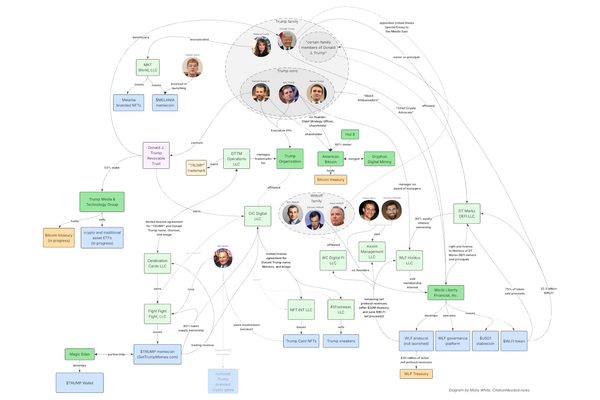Issue 2 – Scrappy startups
Celsius & Voyager tire fires, litigious cryptobros, and a 'scrappy startup'

I'm so grateful for all the support the past week for this newsletter. Both have been received really well, and I'm so excited that you're all excited about what I'm working on!
Coming up
The September 5–6 Crypto Policy Symposium draws ever closer! Watch my panel on "Cryptopias"—blockchain-based "utopias" both physical and virtual—as well as a whole host of other panels and talks from an incredible group of people. Registration is free! Some panels I'm particularly excited for include "The Politics of Bitcoin & Crypto" (David Golumbia and Vili Lehdonvirta, moderated by Izabella Kaminska), "The Crypto Virus: Narrative Economics in the Golden Age of Fraud" (Ben McKenzie and Jacob Silverman, moderated by Izabella Kaminska), "Crypto Contagion" (Frances Coppola, Amy Castor, and Carol Alexander, moderated by Siddharth Venkataramakrishnan), and "The Current State of Regulation" (John Reed Stark and Martin Walker), but it was a challenge not to just list the entire schedule here. Needless to say, I plan to watch every single one.
I've also got a really exciting announcement coming this week, but can't quite let the cat out of the bag yet, so stay tuned! I'll mention it on Twitter in a few days, and I'll be sure to include it in next week's issue for the blissfully less-online among you.
In the news
The Globe and Mail referenced my "Digital artists' post-bubble hopes for NFTs don't need a blockchain" essay in their recent article about the emergence of NFT projects like Doodles. There's also a quote from me about the so-called "utility" of NFTs.
I joined the fabulous Jemima Kelly for her second episode of Tech Tonic's crypto series. The episode also featured Chris Dixon, who leads Andreessen Horowitz's crypto fund, and who refused to talk to Jemima Kelly directly (though who can really blame him, I'd probably also be nervous about talking to an incisive crypto-skeptical journalist such as her if I was in his shoes).
The crypto overview
The much-promised and much-postponed Ethereum Merge might actually happen. It's taken eight years, and has been delayed so many times it's become a running joke both in and outside of crypto, so I'm still waiting until it's done to speak in absolutes. If they're good to their word this time, the developers plan on September 6 to kick off the process of changing Ethereum's consensus mechanism, a change they estimate will complete sometime around September 15. Once implemented, this would transition Ethereum away from the electricity-guzzling proof-of-work model (also used by Bitcoin), and onto a proof-of-stake model (used by some other, much smaller blockchains today like Cardano and Avalanche). This is very good, because it means that Ethereum alone will no longer guzzle the same amount of electricity as Chile, or emit the same amount of CO2 as Finland. But needless to say, I will not be saying "well that's that!" and closing up shop—as Jorge Stolfi put it, "Ethereum going PoS is like assault rifle makers replacing lead bullets with steel bullets because the ammo will be cheaper and more ecological." All the other issues with crypto remain, and may actually get worse as more people and businesses become willing to engage with Ethereum without risking tarnishing their eco-friendly image. There are also risks associated with the merge itself—although the code has been running for a while on a separate test chain, it hasn't been exposed to the full load of the Ethereum network or to the monetary incentives that exist in exploiting it. If all goes well with the merge, it will be business as usual on W3IGG. If not, I could get very, very busy.
It's been a litigious week in an industry where litigation so often ends in hilarity. A crypto YouTuber who goes by "Bitboy Crypto" decided to file a defamation lawsuit against another YouTuber for calling him a "dirtbag influencer" and saying that he "cannot be trusted with financial advice", and then people noticed. The target of the lawsuit raised over $150,000 in donations to fund his legal defense before Bitboy realized he'd made a terrible, Streisand-esque mistake in filing the lawsuit and promised to retract it with a truly heartfelt apology: "I'm sorry it became public". However, the lawsuit revealed something interesting: although Bitboy caveats all his videos (as many crypto influencers do) by insisting they are "not financial advice", he repeatedly refers to himself in the lawsuit as someone who is in the business of providing cryptocurrency investment and financial advice. This is probably not something he should be admitting to, given there are laws about what financial advisors can and cannot do, and the responsibilities they're expected to uphold (such as, maybe, not profiting from shilling scammy shitcoins and then deleting the videos after the coins tank). Anyway, congratulations to Bitboy for cementing the "dirtbag influencer" nickname in the public eye and drawing so much negative attention to himself—far beyond what the target of his lawsuit managed—that one of the most popular YouTubers made a video covering the lawsuit in which he called Bitboy a "pathetic stinky worm".
"Bitboy, don't blow a gasket here. I'm not going to defame you, I'm just here to laugh at you."
The Celsius and Voyager tire fires rage on. Celsius has filed two different lawsuits in an apparent attempt to recoup some funds. One alleges that a group called Prime Trust never returned around $17 million in crypto (at current prices) to Celsius when they severed their relationship in June 2021. It's certainly clear why Celsius is trying to regain those funds now, but it's not clear why they didn't bother to do so for the entire year prior. Celsius's second lawsuit is against KeyFi and Jason Stone, names that might be familiar to W3IGG readers who will recall that those entities sued Celsius in July over a "significant amount of money" owed to them. Celsius has basically come back with a "no, you!" lawsuit, claiming that they actually owe Celsius millions.
Meanwhile, Voyager got the okay from a judge to pay its key employees a collective $1.6 million in bonuses to try to get them to stick around through the bankruptcy. Some Voyager creditors were horrified at the idea of Voyager spending more money when they're looking at taking a haircut on their holdings, but evidently it's pretty common in large bankruptcy proceedings.
I updated the posts excerpting letters from customers to the judges in both the Celsius and Voyager cases. These include a person who convinced his disabled father to let him invest his pension money into Celsius and still hasn't told him it might all be gone (docket 490), a person who deposited their life savings into Celsius only three weeks before the withdrawal freeze (docket 503), a disabled person who deposited their personal injury settlement money into Celsius and is now at risk of becoming homeless (docket 529), a person who is now demolishing the walls of their home by themselves "at high risk" because they can no longer afford contractors (docket 563), and someone who used their entire retirement account of $3 million to take out a loan on Celsius that's at risk of being liquidated (docket 572). Particularly gruesome is the letter writer who included a screenshot of an email in which they begged Celsius customer support to allow him to withdraw even some of his assets to pay for his mother's medical bills. "I have already sought help from my friends and family but there is [only] so much they can do." The support representative replied to say that no, that's not possible, and signed off with, "Best regards and HODL on!"
Among the Voyager letters was one from a senior citizen whose "younger friends and family, who thought they were trying to help [her]" convinced her to put money into crypto. The breakdown of her investments reflects an account balance of under $400 at today's prices, with a large portion of holdings in the "Luna Classic" (LUNC) token. This is the original Luna token belonging to the Terra ecosystem, which collapsed spectacularly in May. If she acquired her stash of Luna tokens prior to the collapse, she may have paid between $1 million and $27 million for them.
The Web3 is Going Just Great recap
Note: If you're a dutiful follower of the W3IGG site and don't need a recap, you can scroll on past to the "Week in review" section.
It was a much quieter week after an unusually busy one last week. There were eight new entries between August 21 and August 26.
Crypto gaming CEO squanders nearly $2 million trading treasury funds
[Link]
We've seen it before, and I'm sure we'll see it again: someone with access to a project's treasury decides to use their genius trading skills to make some extra cash, only to learn the hard way that gambles don't always pan out. I suspect a fair bit of this was happening during the winter bull run and was just chalked up to proper treasury management, but with a change in the markets, we're seeing more projects get caught out.
In this case, it was Ragnarok, which is supposed to be some kind of metaverse massively-multiplayer online role-playing game (MMORPG for you nerds), and which is not to be confused with the other, non-crypto MMORPG with that name (do these people ever google the names before launching?). Its CEO, who goes by Fanfaron, decided to "invest" some of the project's treasury into ETH, repeatedly exiting and then re-entering positions until he lost $1.827 million dollars.
He then admitted to it in a blog post that he published because he wanted to own up to his mistakes got caught by a bunch of investors in the project who published a 38-page-long report detailing the blockchain record of his actions he apparently didn't think anyone would notice.
In addition to the treasury mismanagement, investors realized (and Fanfaron confirmed) that he had been paying himself and some core team members exorbitant salaries. "We're a scrappy startup," Fanfaron wrote in the post, after also acknowledging that he pays himself $50,000 a month ($600,000 a year)—a number he already reduced from his original salary of $1.2 million per year.
Understatement of the week
[Link]
The ENS DAO is the group that controls the Ethereum Name Service, something you've seen (if not recognized) if you've seen people with usernames that end in .eth. It's supposed to be like a web3 equivalent of DNS, the system that tells your browser which URLs map to which servers. It's partially used so that people don't have to remember long and unreadable crypto wallet addresses (like 0xd8da6bf26964af9d7eed9e03e53415d37aa96045) and can just remember a username (like vitalik.eth).
However, some people have also been using it to host websites on a peer-to-peer protocol called IPFS, which can be visited in the browser using a service called eth.link. This was really handy, and a lot of people and other applications began relying on this. However, chaos has struck because the eth.link domain has expired (domains need to be renewed periodically) and the owner of the domain is, as ENS DAO put it, "currently unavailable".
"Currently unavailable" has earned itself the title of "understatement of the week", because the domain owner is Virgil Griffith, and he's "unavailable" because he is sitting in federal prison after trying to help the North Korean government evade sanctions using crypto.
ENS DAO tweeted a warning that the domain is due to be released on September 5, at which point it will be a free-for-all for people who inevitably try to snap it up. They wrote, "If the name expires and is acquired by someone with ill intent, the damage they could do via phishing is substantial - so please update your links and alert your users of the issue immediately."
You have to admit, it's a little funny that GoDaddy of all things has been the undoing of a pillar of the web3 space, an ecosystem that prides itself in decentralization and freedom from large tech companies. There does exist a collectively-run alternative—eth.limo—which is where people are being encouraged to migrate, but it was quite a bit less widely used.
For more on Virgil Griffith's crime, and whether or not the sentencing is just, I'd recommend checking out Episode 68 of Crypto Critics' Corner: "Evading North Korean Sanctions 101".
Sub-primate lending: an update
[Link]
Remember BendDAO and those $5.3 million worth of Bored Ape NFTs that had been used as collateral for loans and were at risk of being liquidated? Well, panicked lenders fearing that the assets they'd deposited in BendDAO might go up in smoke all decided to withdraw them at once, resulting in a bank run that left the project with only 5 ETH ($8,200) in its purse. They had other assets to back the loans: the apes and other NFTs that had reached the liquidation threshold for their loans and could be sold at auction. The only problem was that the project's smart contracts didn't allow them to sell off the NFTs at much of a discount, and there isn't as much demand for these NFTs as there used to be. "We underestimated how illiquid NFTs could be in a bear market when setting the initial parameters", they later wrote.
Somehow, the bank run ended before the reserves ran out (barely), and the project continues on. After the close brush with crisis, the project also voted to pass a set of new terms that aim to prevent this from happening again, primarily by making loan terms less appealing to prospective borrowers.
Everything else
- Group charged for stealing over $4 million in transaction reversal scheme [Link]
- SudoRare NFT exchange rug pulls for $820,000 [Link]
- 10% of Ethereum nodes at risk of being booted from cloud hosting provider [Link]
- Researcher zachxbt alleges that teenager who stole crypto worth $37 million in 2020 is responsible for a spate of crypto-related Twitter hacks [Link]
- The latest Pokémon-themed rug pull nets $708,000 [Link]
Week in review
I spent a bit of time updating the newsletter layout, as you might notice if you're reading this on the web version (newsletter.mollywhite.net for those who want to check it out). I've added an illustration to the blog header, and I spent a little time putting together a dark mode for both this newsletter and for my blog where I publish everything else. Coming soon: a toggle to switch between the modes (for now it just pulls from your system preferences). I'm also planning to see if I can get the emails to respect dark mode preferences, but that might be outside the featureset of my Mailchimp plan.
I also spent some time migrating Web3 is Going Great off of Cloudflare. They've got a great free service that provides a CDN and DDoS protection, but they also have a nasty habit of providing services to some of the worst of the internet. Sorry if you happened to visit the site during that migration, DNS changes are always a pain and there were some blips where you might've seen a certificate warning or (very briefly) downtime.
I played a few hours of Bear & Breakfast, which is extremely cute and features this image.

It was thoroughly enjoyable for those few hours, and now I'm at the stage where it's either about to get repetitive and I'll lose interest, or it will introduce a new mechanic.
It's been a banner week for Atlas, who's practicing playing fetch off-leash without wandering off. If you subscribe to the dog years theory he's about like a twelve-year-old, so the distractability level is high, particularly when paired with a high prey drive for critters like chipmunks and a love for passersby.

He's also working on a new trick, "spin", which I think will be really cute. I think he gets dizzy doing it, though—after a bunch of practice he got halfway around and then sort of flopped over.
Zucchini season seems to be winding down and we are now entering the glorious tomato season. The cherry tomatoes have been ripe for a bit, but the larger variety only just began ripening. I've got a pack of bacon and some bread and I am ready. to. rumble.
Worth a read
That's right, I define "read" just as loosely here as I do over at my reading lists (which I am terribly behind on updating). The TRASHFUTURE folks talk about former WeWork CEO Adam Neumann's latest crypto venture, a topic I covered in W3IGG last week but with much less detail and hilarity.
File this one under "yes, skeptics have been saying this for ages!" It also made Bitcoin maxi Alex Gladstein get really mad at a totally different journalist on Twitter for some reason, so that's probably a good sign.
Nicholas Weaver filed an amicus letter for the Celsius bankruptcy, writing that "there appears to be a significant deception being perpetrated on the court by the management of Celsius" and detailing how Celsius's plan to rescue their business through Bitcoin mining is a farce.
This sounds like a huge win for open access, although there are a lot of details that need to be hammered out before it's possible to predict the effect on scholarly publishing. It is possible that the costs associated with the policy could fall on scholars, ultimately adding barriers to publishing—let's hope not.
For more on the Cloudflare thing I mention above.
Did you know…
I get a lot of joy out of those little moments that make you go "huh, I learned something new today". I wanted to include this section in last week's newsletter, but it was getting very long, so I decided to cut it. Here's last week's:
Have you noticed that newer cars don't have long antennas on the hoods? During a long drive I noticed that the only cars that seem to have antennas were jeeps, pickup trucks, or older model cars. But why?
To pick up FM radio signals, you need an antenna, but it turns out that you can't just take any length of metal rod and pick up those sweet tunes equally well.
[I]deally, its length should match the wavelength of an FM signal, which, at about 100 Mhz, comes to around a wavelength of roughly ten feet.
Now, I bet you're thinking, wait a minute there, Jayjay Torch—I've sure as hell never had a car with a freaking ten foot antenna! And, of course, you're right. A ten foot antenna would be ridiculous. Luckily, antennas work almost (longer antennae do work better, but still) as good if you make them some reasonable fraction of the wavelength you want to get—in the case of most car radio antennae, that's about a quarter the wavelength.
So, the standard antenna size on most cars, for decades, was this 1/4 wave antenna size, which comes to about 2.34 feet, or around 31 inches. If your car has a telescoping antenna, you can get a good sense of the difference proper length makes by noting how much better reception is when the antenna is fully extended to the 1/4 wavelength size as opposed to shorter.
– Jalopnik
But these days, instead of 31-inch antennas, cars tend to have those little shark fins—what I until this week assumed were stuck there for some aerodynamic purpose (though in hindsight it doesn't seem like that little fin would do much aerodynamically). As it turns out, car manufacturers have taken that same length of conductive material and coiled it up inside those little fins. A lot of them also have other antennae inside as well, like for satellite radio. In some cases, cars have a little stumpy antennae that pokes up off the back of the roof—those also use the coiling method to reduce the length.
But why do jeeps and trucks still have the long, hood-mounted antennas? For one, they are more utilitarian in style and so don't need the sleeker little fin to try to match sleek aesthetics like with sedans or SUVs. But also, they tend to be more widely used in rural areas where signal strength is more important, and it turns out that those long antennas still pick up better signal than the fins, which sacrifice your FM radio quality for aesthetics.
Congratulations if you are one of today's lucky ten thousand, as I was last week.
![I try not to make fun of people for admitting they don't know things. Because for each thing 'everyone knows' by the time they're adults, every day there are, on average, 10,000 people in the US hearing about it for the first time. [A list of equations.] Fraction who have heard of it at birth = 0% Fraction who have heard of it by 30 ≈ 100% US birth rate ≈ 4,000,000/year Number hearing about it for the first time ≈ 10,000/day If I make fun of people, I train them not to tell me when they have those moments. And I miss out on the fun. [Megan is standing. Cueball is walking, with his palm out.] Megan: 'Diet Coke and Mentos thing'? What's that? Cueball: Oh man! Come on, we're going to the grocery store. Megan: Why? Cueball: You're one of today's lucky 10,000.](https://www.citationneeded.news/content/images/image/fetch/f_auto,q_auto:good,fl_progressive:steep/https-3a-2f-2fbucketeer-e05bbc84-baa3-437e-9518-adb32be77984.s3.amazonaws.com-2fpublic-2fimages-2f83eaa1d5-a7f2-4704-bc24-60cf323a0c2d_462x316.jpg)
Shoutouts
I'd like to extend a shoutout and a huge thank you to the generous Patrons who subscribed at the "accomplice" tier or above, including Rachel Anne, Joshua Buergel, cc, Joel Dodge, Kyle Johnson, Luke Mastalli-Kelly, Ross Nicoll, David "dpp" Pollak, Liron Shapira, and Nikhil Verma.a You're wonderful, and I'm so grateful for your support.
That's all for now folks. Until next time,
– Molly
Footnotes
This newsletter originally made references to Patreon, because I started on that platform. ↩




